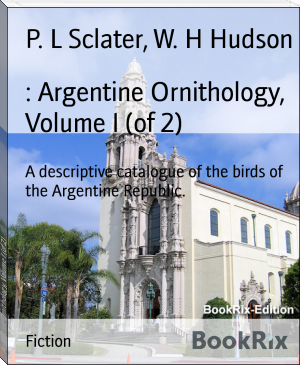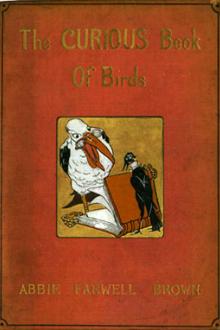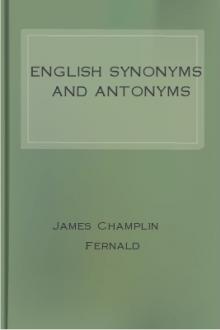: Argentine Ornithology, Volume I (of 2), P. L Sclater, W. H Hudson [best authors to read txt] 📗

- Author: P. L Sclater, W. H Hudson
Book online «: Argentine Ornithology, Volume I (of 2), P. L Sclater, W. H Hudson [best authors to read txt] 📗». Author P. L Sclater, W. H Hudson
4·4, tail 3·4.
_Hab._ Brazil, Paraguay, Buenos Ayres.
Durnford tells us that this species is a summer visitor to the
neighbourhood of Buenos Ayres, but not very common. White met with
it in the forests of Campo Santo in November; and Barrows obtained
specimens among the Paradise-trees in the Plaza at Concepcion, in the
same month of the year.
160. HIRUNDINEA BELLICOSA (Vieill.). (WARLIKE TYRANT.)
+Hirundinea bellicosa+, _Scl. et Salv. Nomencl._ p. 51; _White, P. Z.
S._ 1882, p. 607 (Catamarca). +Hirundinea rupestris+, _Scl.
Ibis_, 1869, p. 198, pl. v. fig. 8.
_Description._--Above sooty brown; wings blackish, with a large
ferruginous red blotch occupying the greater portion of the
inner primaries and secondaries; rump and greater part of the
tail-feathers ferruginous red; apical portion of tail-feathers
blackish: beneath ferruginous red, throat greyish; under
wing-coverts and inner webs of wing-feathers, except the tips,
similar to the belly, but brighter; bill and feet black: whole
length 7·0 inches, wing 4·3, tail 2·2. _Female_ similar.
_Hab._ S.E. Brazil, Paraguay, and Northern Argentina.
This Flycatcher is by no means common in Catamarca. It is seen about the
houses in pairs, but not more than one pair at a time at one dwelling,
perched upon some projection, whence it darts off into the air at
passing insects.
"The snap of its beak, as it dashes at the flies, can be heard a long
way off. Its cry is peculiar and piteous. There is no perceptible
difference in plumage between the male and female."--_White, l. s. c._
161. MYIOBIUS NÆVIUS (Bodd.). (LITTLE BROWN TYRANT.)
+Myiobius nævius+, _Scl. et Salv. Nomencl._ p. 51; _White, P. Z. S._
1882, p. 607 (Buenos Ayres); _Barrows, Bull. Nutt. Orn. Cl._ vol.
viii. p. 201 (Entrerios).
_Description._--Above brown; lores whitish; concealed vertical crest
red or yellow; wings blackish, two bands across the coverts and
outer margins of external secondaries pale rufous or fulvous,
sometimes whitish; tail dark brown: beneath fulvous white; sides of
throat, breast, and flanks more or less distinctly flammulated with
brown; under wing-coverts pale fulvous; bill brown; lower mandible
whitish; feet blackish: whole length 4·7 inches, wing 2·5, tail 2·3.
_Female_ similar, but crest yellow or absent.
_Hab._ Veragua and Cisandean South America down to Argentine Republic.
This small Tyrant-bird is a summer visitor in the Plata district; it
is shy and solitary; frequents woods and plantations, and perpetually
utters, like the English Redstart, its sorrowful monotonous plaint, as
it flits about in the upper foliage of the trees.
The nest is placed in a bush or low tree, and built of various soft
materials compactly woven together, and the inside lined with feathers
or vegetable down. The eggs are four, pale cream-colour, with large,
well-defined spots of dark red.
The total length of this species is less than five inches. The
prevailing colour of the plumage is rufous brown on the upper, and
whitish brown on the under surface. Beneath the loose feathers of the
crown there is a concealed spot of orange-red.
162. PYROCEPHALUS RUBINEUS (Bodd.). (SCARLET TYRANT.)
+Pyrocephalus rubineus+, _Scl. et Salv. Nomencl._ p. 51; _Hudson,
Z. S._ 1872, p. 808; _Durnford, Ibis_, 1877, p. 178(Buenos Ayres); _Gibson, Ibis_, 1880, p. 27 (Buenos Ayres);
_Barrows, Bull. Nutt. Orn. Cl._ vol. viii. p. 201 (Entrerios).
+Pyrocephalus parvirostris+, _Burm. La-Plata Reise_, ii. p. 456
(Entrerios).
_Description._--Above very dark cinereous, crested head and body
below scarlet; bill and feet black: whole length 5·2 inches, wing
2·9, tail 2·3. _Female_ above paler cinereous, below white; breast
striated with cinereous; belly more or less rosy red.
_Hab._ S. America, from Colombia down to Buenos Ayres.
It is in vain, I think, to attempt to make more than one species out
of this widely-spread bird, though specimens from the west coast are
usually smaller.
The Scarlet Tyrant is about five inches and a half long; the neck, back,
wings, and tail are black, all the rest of the plumage the most vivid
scarlet imaginable. The loose feathers of the crown, which form a crest,
are especially brilliant, and seem to glow like a live coal amidst the
green foliage. Beside this bright Tyrant-bird even the Rainbow Tanagers
look pale, and the "Jewel Humming-birds" decidedly sad-coloured. It is
not strange, therefore, that in South America, where it has a very wide
range, it is a species well known to the country people, and that they
have bestowed on it many pretty names, most of which have reference to
its splendid scarlet colour. In the Argentine Republic it is usually
called _Churinche_, from its note, also _Federál_ and _Fuegéro_; in
other countries _Sangre de Toro_ (bull's blood), and, better still,
_Sangre_ _Pura_. Little Soldier and Coal of Fire are also amongst its
names. The Guarani tribes call it _Guira-pitá_ (red-bird); but another
Indian name, mentioned by d'Orbigny, is the best--_Quarhi-rahi_, which
signifies Sun-born.
The Churinche appears in Buenos Ayres about the end of September, and is
usually first seen in localities to which Tyrant-birds are partial, such
as low grassy grounds, with here and there a stalk or bush, and near a
wood or plantation. Insects are most abundant in such places; and here
the Churinche is seen, perched on a twig, darting at intervals to snap
at the flies after the fashion of the Flycatchers, and frequently
uttering its low, plaintive note. It is very common in the woods along
the Plata; every orchard on the pampas is visited by a few of them; and
they are very abundant about Buenos Ayres city. Going south they become
rarer; but, strange to say, a few individuals find their way to the
shores of the Rio Negro, though before reaching it they must cross a
high, barren country quite unsuited to them. The natives of the Carmen
have no name for the Churinche, but speak of it as a bird wonderful for
its beauty and seldom seen. Amongst the dull-plumaged Patagonian species
it certainly has a very brilliant appearance.
A very few days after their arrival the Churinches pair; and the male
selects a spot for the nest--a fork in a tree from six to twelve feet
from the ground, or sometimes a horizontal bough. This spot the male
visits about once a minute, sits on it with his splendid crest elevated,
tail spread out, and wings incessantly fluttering, while he pours out a
continuous stream of silvery gurgling notes, so low they can scarcely be
heard ten paces off, and somewhat resembling the sound of water running
from a narrow-necked flask, but infinitely more rapid and musical. Of
the little bird's homely, grey, silent mate the observer will scarcely
obtain a glimpse, she appearing as yet to take little or no interest in
the affairs that so much occupy the attention of her consort, and keep
him in a state of such violent excitement. He is exceedingly pugnacious,
so that when not fluttering on the site of his future nest, or
snapping up some insect on the wing, he is eagerly pursuing other male
Churinches, apparently bachelors, from tree to tree. At intervals he
repeats his remarkable little song, composed of a succession of sweetly
modulated metallic trills uttered on the wing. The bird usually mounts
upwards from thirty to forty yards, and, with wings very much raised and
rapidly vibrating, rises and drops almost perpendicularly half a yard's
space five or six times, appearing to keep time to his notes in these
motions. This song he frequently utters in the night, but without
leaving his perch; and it then has a most pleasing effect, as it is less
hurried, and the notes seem softer and more prolonged than when uttered
by day. About a week after the birds have arrived, when the trees are
only beginning to display their tender leaves, the nest is commenced.
Strange to say, the female is the sole builder; for she now lays by
her indifferent mien, and the art and industry she displays more than
compensate for the absence of those beauties and accomplishments that
make her mate so pleasing to the sight and ear. The materials of which
the nest is composed are almost all gathered on trees; they are lichens,
webs, and thistle-down: and the dexterity and rapidity with which they
are gathered, the skill with which she disposes them, the tireless
industry of the little bird, who visits her nest a hundred times an hour
with invisible webs in her bill, are truly interesting to the observer.
The lichens firmly held together with webs, and smoothly disposed with
the tops outside, give to the nest the colour of the bark it is built
on.
After the Churinche's nest is completed, the Bienteveo (_Pitangus
bolivianus_) and the Common Cow-bird (_Molothrus bonariensis_) are the
troublers of its peace. The first of these sometimes carries off the
nest bodily to use it as material in building its own; the female
Cow-bird is ever on the look out for a receptacle for her eggs. Seldom,
however, does she succeed in gaining admittance to the Churinche's nest,
as he is extremely vigilant and violent in repelling intruders. But his
vigilance at times avails not; the subtle bird has watched and waited
till, seizing a moment when the little Scarlet Tyrant is off his guard,
she drops her surreptitious egg into his nest. When this happens, the
Churinches immediately leave their nest. The nest is sometimes lined
with feathers, but usually with thistle-down; the eggs are four,
pointed, and spotted at the broad end with black; usually each egg has
also a few large grey spots. The young are at first grey, marked with
pale rufous, but soon become entirely grey, like the female. In about a
month's time the belly of the males begins to assume a pale mauve-red;
this spreads upwards towards the breast and throat; and finally the
crest also takes on this colour. The Churinches raise two broods in a
season--but if the nest is destroyed, will lay as many as four times.
The Scarlet Tyrant is the first of our summer visitors to leave us. As
early as the end of January, and so soon as the young of the second
brood are able to feed themselves, the adults disappear. Their going is
not gradual, but they all vanish at once. The departure of all other
migratory species takes place after a very sensible change in the
temperature; but at the end of January the heat is unmitigated--it is,
in fact, often greater than during December.
When the adults have gone, the silent





Comments (0)